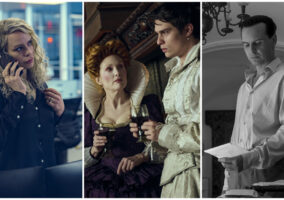Lots of stories being told through color this episode. And since it’s 1968, costume designer Janie Bryant had a whole lot of colors to work with. Curiously, she chose to focus mostly on two.

Standard middle class suburban wear. No one’s really wearing the latest anything in these pictures. The women are dressed in a manner very similar to Betty Francis, especially the one with the scarf. They’re put-together and presentable, but these are sturdy 1965-or-so clothes. Every wife matches her husband in this scene. It’s extremely subtle and we actually had to rewind it to make sure each man wound up with the matching woman as they walked out the door, but blue dress walked out with blue tie and gold dress walked out with gold tie.

Pete and Trudy match in tones of gold and green. Janie Bryant will do this quite a bit with couples. It’s a subtle way of signaling who “belongs” to whom in a scene, working on a subconscious level. Pete and Trudy just look like they’re together in this scene, even as they spend most of it apart. In fact, the extreme matchiness of the couples here (moreso than normal, even for Janie Bryant) is probably meant to play up the fact that every person in this room is flirting with someone else’s spouse.

Much like Betty in her creams and blues back in Ossining, Trudy is very tied to her home through the use of color and pattern. Much like Betty mimicked the plaid of her kitchen wallpaper by wearing plaid pants and plaid shirtwaist dresses, Trudy favors prints and florals that mimic all the floral patterns in her home. Here, she’s sporting autumnal tones that practically make her one with her living room.
Trudy always favored prints – in fact, prior to Megan she was the character most often wearing prints – but her prints got louder and larger when they moved to Connecticut. Part of that is, of course, due to the wildness of the times, sartorially speaking. But it also helps to give every scene in Pete’s home a buzzing sort of tension. He hates this house. Trudy matches this house exactly and protects it fiercely. Each scene is filled with conflicting and competing patterns to enhance these feelings. “This is my home. I am of my home.” “I hate this place and I hate you for making me stay in this place.”

It’s a shock to see Sylvia dressed this way, both to us and to Don. It’s a shock to us because Sylvia has only been presented in sultry or ominous black in the story. This explosion of color and frippery upends our notions about her, as it does the same to Don, who’s taken aback to see this scene of domesticity play out between his mistress and her husband. It’s also a shock to us because it looks so utterly ludicrous. No one dresses like this anymore. Of all the pampered-wife looks we’ve ever seen on this show, no wife ever looked so pampered and so silly. It’s a perfect representation of what’s going on in the scene, as she pouts and asks her wealthy husband for money. Had she been dressed in some sort of sexy Megan bathrobe or frumpy Betty bathrobe, this scene never would have worked as well as it does.
Once again, Don and Arnie are dressed alike, both working a dark and light grey combination with hints of red peeking underneath. Once again, Arnie is wearing a light over a dark and Don is wearing a dark over a light.

It would be so like Peggy to insist on a black secretary because Don has one. And it’s typical of how Peggy doesn’t always quite see people for who they are except in the ways that they can help her or she can use them. In other words, Don has a black secretary and Peggy kind of fucked up that relationship last year by inadvertently accusing her of being a thief, so she’ll just get one for herself and start over. We suspect a lot of Peggy fans are not going to like us for making that point. Peggy is a super-human ad-woman and a trail-blazer, but she’s been shown time and again to have a tin ear when it comes to the social and political changes going on around her.
At any rate, whoever she is, she’s fabulous. It’s a little surprising to see the most glamorous and with-it secretary on the show in an office other than SCDP. She’s sporting the very latest in pale lipstick, colored tights and wild prints. She’s probably no more than 6 years younger than Peggy, who might as well be her mother for the way she’s dressed in the scene.

That sense of solid maturity is only enhanced in this continuation of the scene, where she’s up against her baby-faced copywriters. It’s interesting how, ever since she moved to CGC, she’s surrounded by people younger than her. You rarely saw that at SCDP. Anyway, in the interaction with her secretary, the bright colors of her suit tended to fight a bit with her secretary’s wild print and bright red. Here, it’s a bright line, demarcating the difference between herself and the colorless, mopey, child-like men who work for her.

We’re not going to pretend to know why, and we’re not going to attempt to spin out a theory, but the blue-and-green color combo was really prominent this episode. The thing about color theory as a form of critical analysis is that it’s so outrageously personalized. Red means passion. But it also means anger, and blood, and violence. In the right setting, it can mean communism. It’s possible Janie has a specific message in mind with this repeating motif, or it’s possible she’s simply using it because, as we said when we noted it in episode 1 with Peggy, it’s a popular and very of-its-time combination. Either way, we’re keeping an eye out for it.
Pete’s seedy little bachelor pad looks eerily like Peggy’s apartment.

As for Pete’s little friend, it’s notable that, like Sylvia last week, she’s a column of ominous black, even when she’s half-naked. Sylvia still entices Don, but Pete’s little assignation wound up blowing up his life. Foreshadowing? Will “women in black” be a theme this season? Because we had an entire room full of women in black at Roger’s mother’s funeral.

Blue and green. Ketchup guy’s blue suit – which is clearly the most expensive and newest in the scene, illustrating his sharpness and ambition – is a focal point in the scene and Ken’s green suit provides a counterpoint. Most of the other men fade away, although it’s notable that Don is also in a dark blue. He’s been working more blue into his wardrobe this year.

Blue and green. Here, we’re looking at opposing forces of a sort. Each woman has an agenda, but their agendas are wildly different from each other. Megan just wants a friend to confide in, but Sylvia clearly wants to keep the relationship as light and on-the-surface as possible. Up until this conversation, she never really considered Megan a real person.

Megan is dressed in a youthful sweater and plaid pants while Sylvia’s maturity and comfort in her role as a wealthy man’s wife is more apparent. Her dress is embellished, her hair is set, and she’s wearing way more jewelry than Megan is. On the surface, you wouldn’t think these women have much in common. Enter Don, a dark column in the room, throwing the balance off and reminding us all of what they have in common.
Like we said, color theory can get pretty shaky when you try and apply exact meanings to colors, but we’re going to go out on a limb here and suggest that, at least in this part of the story, blue is signaling motherhood. Sylvia is a mother, Megan is not; and the whole scene was pretty much about that, on the surface.

Peggy’s getting more stylish by the second. That’s a 1968 version of a 1962 Joan Holloway dress. Check out how short the skirt is. Minis went from shockingly vulgar to accepted in a ridiculously short period of time. Peggy’s not the most fashion-forward person in the world, so if she’s wearing her skirt this short in the office, you can bet a whole lot of other women are as well.
Ted blends in perfectly with his surroundings, the orange of his suit and tie merging with all that honey blonde wood in his office. This is another signal of how standard wear reflected the wilder styles of the time. He’s a successful businessman, well into his 30s, and he’s in an orange suit. Think about that.

This outfit had one purpose in this scene: to be as declarative and bold and “fuck you” as possible. She dominates every setting and background in this. That’s no small feat when you’re dressing a character known for her bold style choices. There’s a lot about this look that reads mature, though. Joan is favoring vests and vest-like dresses this year, which attempt to mimic menswear in order to signal her role as a partner. But vests aren’t exactly flattering on a woman shaped like Joan and when you add the scarf at the neck (a very old school Joan mainstay), and the charm bracelet, and even the typical Joan up ‘do, you get the very image of the middle-aged female office worker of the period. She looks formidable and put together, but she doesn’t look 1968 stylish or youthful. Not that she should; just that there’s a very clear line separating her from Megan and Peggy.
If Joan’s still working in 1980, she could dress just like this and no one would bat an eye. In many ways, it’s standard business-wear all through the 1970s. Picture “9 to 5.” Half the background players were dressed like this.

Once again, Peggy is professional and put-together. The men in her life (including Abe but with the VERY NOTABLE exception of Ted Chaough) are all slobs or dress like little boys. She is so going to have an affair with Ted, isn’t she?

Megan is often dressed to look both younger and less powerful than Don. Of all the women on this show, we don’t think we’ve ever been treated to so many nightgowns and bathrobes in one character’s wardrobe. And when she’s not in sleepwear in the apartment, she’s usually seen barefoot or in very casual, slightly juvenile clothes.
This hideous bathrobe is a more youthful (no, really) version of Betty’s satin-y, puffy, synthetic nightmare of last episode. This sort of faux-old-fashioned print and style -especially in sleepwear – was very popular at the time and would signal the adoption of prairie dresses and other such retro affectations on the pop culture scene in the years to come, from Holly Hobbie to Little House on the Prairie. Even her bathrobes are trendier than Betty’s or Sylvia’s.
Blue, as she tells him about her miscarriage and they dance around the idea of having children without actually discussing it.

Blue once again, to call back to and remind you of her earlier blue dress and even of Megan’s bathrobe. Blue, in a dark scene almost devoid of color. This whole dinner scene centered around Sylvia’s discomfort with the idea that Megan and Don aren’t drifting apart and that Megan could’ve been pregnant with his child while they’ve been carrying on. It’s notable that Sylvia got a little judgmental with Megan over the abortion question, but we think that judgmentalism was really about herself and the fact that she was in danger of breaking up this marriage.
Didn’t stop her from hopping back into bed with him, though.

Trudy is once again a buzzing, loud autumnal-toned print in her home, overwhelming the scene and assaulting the eyes a little. It’s discordant and it just feels wrong, which is how Pete is supposed to see this scene. It’s also extremely notable that Trudy’s dress matches the blonde’s sweater.

Blue and green. Not only does her print not fight with the room the way so many of her others have, but it’s also not an overly floral print. Instead, there are bold, declarative stripes. In many ways, this outfit is atypical for Trudy; not just because of the stripes, but because of the more modern shape and shorter skirt. In fact, this is the first really 1968-modern dress we’ve seen her wear; a simple, relaxed shape rendered in really bright colors. Everything else always felt just slightly behind the times, ever since she had the baby.

Blue and green. But of course, the coat comes off early in the scene and from that point on, she and Ted are matching and on the same page. She protested going after Heinz, but it was as feeble a protest as Peggy ever managed. She wanted to do this and she knew what she was doing. She just needed Ted to convince her to take her coat off. Sex as a metaphor for business (and vice versa).
She will always find a way to work a Peter Pan collar into her wardrobe.

After the blacks of the first two episodes and all the blues in this episode, it’s a surprise to see Sylvia in this bright red.

But not really. All women are the same woman in the eyes of Don Draper.
[Stills: tomandlorenzo.com]
Mad Men: The Collaborators Next Post:
Mad Men: To Have and To Hold
Please review our Community Guidelines before posting a comment. Thank you!



